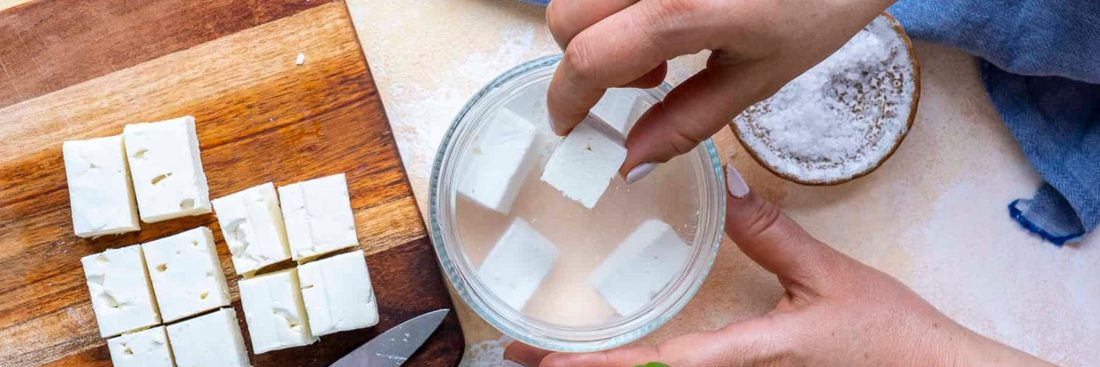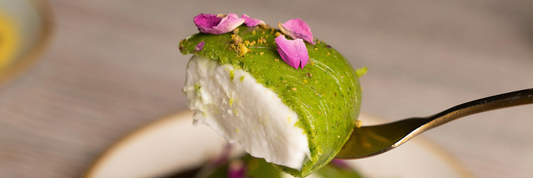How to brine feta cheese is a key technique for preserving this classic Greek cheese. Soaking feta in a saltwater solution keeps it moist, intensifies its salty tang, and extends its shelf life. This process ensures feta stays fresh and flavorful, perfect for Mediterranean dishes.
- Feta Cheese Explained: Origin, Health Benefits, and Serving Ideas
- How to Store Feta Cheese Properly
- Types of Feta Cheese: A Guide to Varieties, Flavor, and Uses
- How to Make Homemade Feta Cheese easily
What Is Brining?
Brining is a traditional food preservation and flavor-enhancing process that involves soaking food items in a concentrated saltwater solution called brine. This technique dates back centuries and is widely used globally to preserve and improve the taste and texture of various foods, including meats, vegetables, and cheeses.
- Brine is typically a mixture of water and salt, but it can also include other optional ingredients such as sugar, herbs, spices, or acids (like vinegar or citrus juice) depending on the intended flavor profile and food type.
- The salt concentration in brine usually ranges from about 5% to 20%, depending on the recipe and food being brined.

Purposes of Brining
- Preservation
Brine creates an environment hostile to many spoilage microorganisms by reducing water activity, effectively inhibiting bacterial and mold growth. This naturally extends the shelf life of perishable products by slowing down spoilage and decay. - Flavor Enhancement
Salt helps penetrate the food, seasoning it evenly throughout. Brining also enhances natural flavors and can balance or mellow harsher tastes, adding complexity and depth to the final product. - Texture Improvement
The salt concentration causes protein structures in meats or curds in cheese to change, often improving moisture retention and tenderness. For example, in meats, it helps muscle fibers retain water, making them juicier and more succulent. In cheese, brining keeps curds soft and creamy while preventing them from drying out.
How Brining Works
- When food is immersed in brine, salt ions move into the food via diffusion, while moisture movement depends on concentration gradients.
- This exchange causes moisture retention inside the food and helps regulate microbial activity on the surface and inside.
- The salt concentration is balanced so that it preserves but does not excessively dehydrate the food.
Role of Brining in Cheese-Making, Especially Feta
Brining is an essential stage in the production of many traditional cheeses, notably feta, and it greatly influences the cheese's sensory and preservation qualities.
Moisture Retention
Feta cheese is known for its moist, crumbly texture. After coagulation and initial draining of the curd, feta is placed in a salty brine solution. This step allows the cheese to retain adequate moisture, preventing it from drying out and maintaining its characteristic softness. The brine bath ensures the curds remain plump and tender rather than becoming hard or crumbly beyond the desired texture.
Flavor Development
The salty environment of the brine infuses feta with its signature tangy and salty taste. The salt slowly penetrates throughout the cheese during aging, achieving a consistent flavor. Additionally, brining helps develop the depth and complexity of feta's slightly acidic, tangy profile, which balances the richness of sheep and goat milk fats.
Natural Preservation and Shelf Life Extension
Brining acts as a natural preservative. The salt concentration inhibits spoilage organisms such as molds and undesirable bacteria, significantly extending feta’s shelf life without the need for artificial additives. This preservation quality allows feta to be stored safely for weeks or even months while maintaining freshness and quality.
Texture and Appearance
- The brining process helps maintain feta’s white color and creamy yet crumbly texture.
- Brined feta remains moist enough to be pliable but firm enough to crumble, which is essential for its use in various dishes like salads, pastries, and baked goods.
Why Brine Feta? Key Benefits of Feta Cheese Brine
Brining is a traditional and indispensable step in making authentic feta cheese, and it plays a multifunctional role that impacts preservation, flavor, texture, and storage efficiency. The process involves soaking the cheese in a carefully prepared saltwater solution, or brine, which not only preserves the cheese but also enhances its distinctive sensory qualities and extends its usability. Here’s an in-depth exploration of the key benefits of brining feta cheese:
Preservation: Slowing Spoilage and Extending Usability
The salty environment created by the brine solution is highly effective at retarding the growth of spoilage microorganisms such as bacteria, molds, and yeasts that would otherwise degrade the cheese. Salt reduces water activity and creates unfavorable conditions for microbial growth, effectively acting as a natural preservative. This allows feta cheese to be stored safely for extended periods often several weeks to a few months without the need for artificial preservatives. The ongoing aging in brine also allows the cheese’s flavors to mature while simultaneously protecting it from drying out or rotting.
Flavor Enhancement: Intensifying Saltiness and Tanginess
Brining imbues feta with its iconic salty and tangy flavor profile. Unlike merely sprinkling salt on the surface, soaking in brine ensures salt penetration throughout the cheese matrix, achieving a consistent and balanced seasoning. The salt interacts with the milk fats, proteins, and lactic acid bacteria in the curds, deepening the complex, savory notes that characterize feta. The acidic tang, a hallmark of feta’s flavor, develops through lactic acid fermentation enhanced by the brine environment, balancing richness with sharpness. This flavor enhancement elevates feta’s culinary versatility, making it a standout ingredient in Mediterranean cuisine and beyond.
Texture Maintenance: Preserving Moisture and Curd Structure
One of the key sensory attributes of feta is its crumbly yet moist texture. The brine acts to retain moisture within the cheese, preventing desiccation and ensuring that the curds remain tender and pliable rather than dry or hard. Without brining, feta would quickly lose water and firmness, resulting in an unappealing texture that lacks the creamy crumble that consumers expect. The osmotic balance created by the saltwater solution gently draws moisture into the cheese, preserving its characteristic softness and making it ideal for crumbling over salads, pastries, or cooked dishes.
Storage Efficiency: Bulk Preservation and Protection from Air
Brining enables producers and consumers to store feta in bulk efficiently. Since the cheese remains submerged in the brine solution, it is protected from exposure to oxygen and contaminants, which could otherwise lead to premature spoilage, mold growth, or drying out. This liquid environment acts as a barrier, maintaining optimal freshness while facilitating safe transportation and extended shelf life. For home use, keeping feta in brine ensures it stays fresh longer than if it were stored dry or loosely wrapped.
Culinary Bonus: Reuse of Leftover Brine
After removing feta from its brining solution, the leftover brine can be repurposed creatively in the kitchen. This salty, tangy liquid serves as a flavorful base for marinating vegetables, poultry, seafood, or even as a brining solution for other cheeses or cured meats. Using leftover brine reduces waste, adds a depth of flavor to other dishes, and connects with sustainable cooking practices. When reused wisely, brine can impart a subtle feta-like flavor and complexity to a wide variety of culinary creations.
Feta Cheese Brine Solution Brining is essential for preserving feta cheese, enriching its flavor, and keeping its iconic crumbly-yet-creamy texture. The brine protects the cheese from spoilage, preserves moisture, and adds to its complex taste. Follow this comprehensive approach to create a brine solution at home:
Basic Brine Recipe & Salinity Ratio
The ideal brine for feta is mildly salty enough to preserve and flavor the cheese without overpowering it or drawing out too much moisture.
- Standard Brine (for everyday storage and mild flavor): Use 2 teaspoons of kosher salt per 1 cup (240 ml) of water. This yields roughly a 5–6% salt solution, perfect for storing feta in the fridge for up to several weeks.
- Stronger Brine (for longer preservation or firmer texture): Mix ¼ cup kosher salt per 4 cups (1 liter) of water, resulting in about 6–8% salinity.
- For extra acidity helpful in mimicking traditional feta brine and stabilizing pH add about 1 teaspoon of white vinegar or lemon juice per cup of brine. This discourages spoilage bacteria and enhances feta’s tang.

Choosing Water and Salt
- Water: Use boiled and cooled water, or filtered water to minimize bacteria and impurities that could affect your cheese.
- Salt: Always use non-iodized salt preferably kosher salt, pickling salt, or pure sea salt. Iodized/table salt can impart bitter flavors and may cloud the brine or affect feta's consistency.
Optional Add-Ins for Enhanced Flavor
To create a brine that subtly infuses more complexity into your feta, consider adding flavor agents:
- Herbs: Fresh or dried oregano, thyme, rosemary, or even a bay leaf.
- Spices: Peeled garlic cloves, a few whole black peppercorns, or a strip of lemon peel can offer gentle aromatic notes.
Add these to the brine as it cools (after boiling) so they can steep, then strain out if desired once the flavors are released.
Sterilization & Cooling – Crucial Steps
- Boil the Water: Bring your measured water to a boil.
- Dissolve Salt (and Acid): Remove from heat, add your measured salt (and vinegar/lemon juice, if using), stirring until fully dissolved.
- Sterilize and Blend: Boiling not only dissolves the salt thoroughly but also sterilizes the brine, reducing risk of introducing unwanted microbes to your cheese.
- Cool Completely: Before adding feta, let the brine return to room temperature. Hot brine can toughen cheese curds and encourage spoilage by "cooking" the outer layer.
- Add Aromatics (Optional): Drop in herbs or spices after water cools but before using the brine.
How to Use
- If storing feta blocks, ensure they are fully submerged in the cooled brine, using a clean food-safe container with a tight-fitting lid.
- Store the brined feta in the refrigerator. The cheese will keep for several weeks to months, developing flavor over time.
Extra Tips for Success
- Replenish Brine as Needed: If you notice the liquid level dropping or the brine becoming cloudy, replace it with a fresh batch.
- Adjust Salt to Taste: For less salty cheese, you can soak slices of feta briefly in fresh water before serving, or use a lower-salt brine if consuming quickly.
- Reuse Brine Creatively: Leftover feta brine makes a great marinade for vegetables, chicken, or fish, and can be the base for tangy salad dressings.
How to Brine Feta Cheese: Step-by-Step Detailed Guide
Brining feta cheese is an essential process for preserving its moisture, developing its characteristic salty tang, and extending its shelf life. Proper brining ensures that your feta remains fresh, flavorful, and maintains its ideal crumbly yet creamy texture. Below is a detailed, stepwise approach to successfully brine feta cheese with tips for timing and storage.
Step-by-Step Instructions for Brining Feta
Step 1: Prepare Your Brine Solution:
- Start by choosing your brine strength based on your preference:
- Standard mild brine: Dissolve about 2 teaspoons of kosher salt per 1 cup (240 ml) of water.
- Stronger brine: For a saltier, firmer feta or longer preservation, use approximately ¼ cup of kosher salt per 4 cups (1 liter) of water (~6–8% salinity).
- Optionally, you can add about 1 teaspoon of white vinegar or lemon juice per cup of water to help stabilize pH and enhance tanginess.
Step 2: Sterilize and Cool the Brine:
- Boil the water first, then add the salt (and acid if using), stirring to dissolve completely and sterilize the solution.
- Allow the brine to cool fully to room temperature before using it on your cheese. Using warm or hot brine can alter the texture negatively or encourage unwanted bacterial growth.
Step 3: Prepare the Container and Feta:
- Use a clean, non-reactive (glass, ceramic, or food-grade plastic) container large enough to hold the feta pieces and cover them completely in brine.
- You can brine feta in whole blocks or cut it into cubes depending on your storage or recipe needs.
Step 4: Submerge the Feta Completely:
- Place the feta cheese in the container and pour over the cooled brine solution, ensuring the cheese is fully submerged.
- To keep feta fully immersed, you can place a small clean weight or plate on top if needed to prevent floating and uneven brining.
Step 5: Seal and Refrigerate:
- Seal the container with an airtight lid or cover.
- Refrigerate the feta submerged in brine to maintain ideal freshness, moisture, and safety.
Timing & Storage Considerations
- Minimum Brining Time:
For quick brining, allow the feta to soak for at least 8 to 12 hours to start absorbing flavor and moisture benefits. Overnight brining is often ideal to develop noticeable saltiness and the correct texture. - Extended Brining:
Feta can be safely kept in brine for 2 to 4 weeks or longer when refrigerated. During this time, the cheese continues to mature in flavor while staying moist and protected. - Signs to Discard:
Monitor the brine condition regularly. If the brine becomes cloudy, develops mold, or emits a sour or off odor, discard both cheese and brine immediately to avoid health risks. - Replenishing or Refreshing Brine:
If you notice evaporation or the liquid level dropping below the feta, add fresh cooled brine solution to keep the cheese submerged.

Uses of Feta Brine
As Marinade or Flavor Booster
Leftover feta brine is a flavorful and handy ingredient that can be repurposed as a marinade or flavor enhancer for various dishes. Here are practical ways to use it:
- Marinate Chicken or Vegetables: Use the brine to soak chicken pieces or vegetables before cooking. The salty, tangy profile of the brine tenderizes and infuses them with Mediterranean-inspired flavors. For example, combining leftover feta brine with olive oil, garlic, herbs (like oregano or thyme), and lemon juice creates an excellent marinade base.
- Flavor Booster: Drizzle or toss vegetables, grains, or salads with a bit of feta brine mixed with extra virgin olive oil and fresh herbs to add a savory, briny punch.
- Add Depth to Sauces or Dressings: Incorporate small amounts of feta brine into vinaigrettes, yogurt sauces, or dips for a subtle salty tang and complexity.
Reusing Feta Cheese Brine
- Storage: Keep leftover brine refrigerated in a sealed container or freeze it in small portions like ice cube trays for later use. Proper storage preserves its flavor and prevents spoilage.
- Safety: Always check the brine before reuse. Discard it if you notice an off smell, cloudiness, mold, or any signs of spoilage to ensure food safety.
Supporting Details and Examples from Recipes
- Feta-brined chicken recipes often use the brine combined with olive oil, garlic, and herbs to marinate chicken thighs or breasts overnight, resulting in juicy, tender, and flavorful meat .
- Leftover brine can serve as a tasty base for marinades paired with roasted vegetables or grilled dishes, enhancing the dish with feta’s characteristic savory tang .
- Some recommended herb and spice add-ins include oregano, rosemary, thyme, garlic, black peppercorns, and lemon zest, which complement the feta brine’s flavor when used as a marinade .
- Marinated feta cheese itself is often kept in olive oil with herbs and spices, illustrating how brining ingredients elevate flavor in both cheese and other dishes.
Conclusion
Knowing how to brine feta preserves its unique texture and flavor while extending freshness. Proper brining brings out the best in feta cheese, making every bite delicious. Leftover brine can also be reused as a tasty marinade, adding value and reducing waste.
If you love eco-friendly products, whether you’re a small shop or a cheese enthusiast, KimEcopak is ready to help. Share your questions, and KimEcopak will send you the perfect eco-packaging options within 24 hours.







